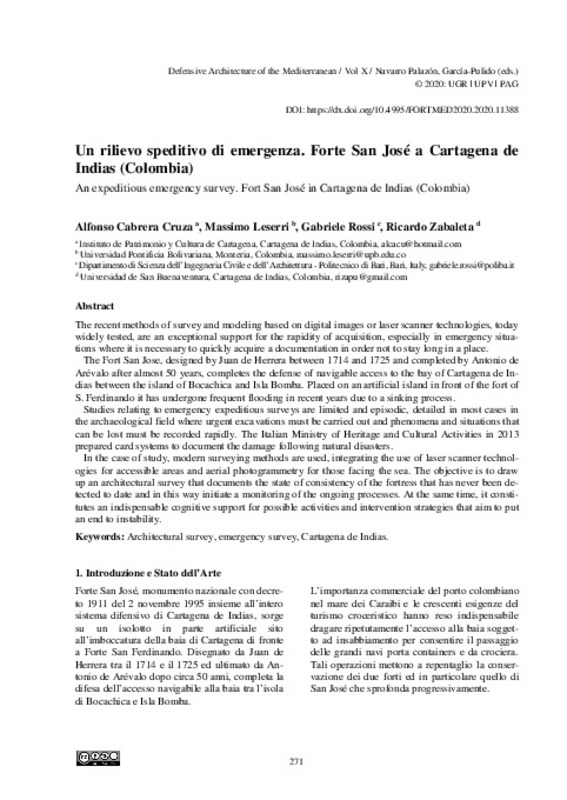JavaScript is disabled for your browser. Some features of this site may not work without it.
Buscar en RiuNet
Listar
Mi cuenta
Estadísticas
Ayuda RiuNet
Admin. UPV
Un rilievo speditivo di emergenza. Forte San José a Cartagena de Indias (Colombia)
Mostrar el registro sencillo del ítem
Ficheros en el ítem
| dc.contributor.author | Cabrera Cruza, Alfonso
|
es_ES |
| dc.contributor.author | Leserri, Massimo
|
es_ES |
| dc.contributor.author | Rossi, Gabriele
|
es_ES |
| dc.contributor.author | Zabaleta, Ricardo
|
es_ES |
| dc.date.accessioned | 2020-06-18T07:11:13Z | |
| dc.date.available | 2020-06-18T07:11:13Z | |
| dc.date.issued | 2020-05-15 | |
| dc.identifier.isbn | 9788490488560 | |
| dc.identifier.uri | http://hdl.handle.net/10251/146555 | |
| dc.description.abstract | [EN] The recent methods of survey and modeling based on digital images or laser scanner technologies, today widely tested, are an exceptional support for the rapidity of acquisition, especially in emergency situations where it is necessary to quickly acquire a documentation in order not to stay long in a place. The Fort San Jose, designed by Juan de Herrera between 1714 and 1725 and completed by Antonio de Arévalo after almost 50 years, completes the defense of navigable access to the bay of Cartagena de Indias between the island of Bocachica and Isla Bomba. Placed on an artificial island in front of the fort of S. Ferdinando it has undergone frequent flooding in recent years due to a sinking process. Studies relating to emergency expeditious surveys are limited and episodic, detailed in most cases in the archaeological field where urgent excavations must be carried out and phenomena and situations that can be lost must be recorded rapidly. The Italian Ministry of Heritage and Cultural Activities in 2013 prepared card systems to document the damage following natural disasters. In the case of study, modern surveying methods are used, integrating the use of laser scanner technologies for accessible areas and aerial photogrammetry for those facing the sea. The objective is to draw up an architectural survey that documents the state of consistency of the fortress that has never been detected to date and in this way initiate a monitoring of the ongoing processes. At the same time, it constitutes an indispensable cognitive support for possible activities and intervention strategies that aim to put an end to instability. | es_ES |
| dc.language | Italiano | es_ES |
| dc.publisher | Editorial Universitat Politècnica de València | es_ES |
| dc.rights | Reconocimiento - No comercial - Sin obra derivada (by-nc-nd) | es_ES |
| dc.subject | Fortifications | es_ES |
| dc.subject | Mediterranean | es_ES |
| dc.subject | Modern age | es_ES |
| dc.subject | Built Heritage | es_ES |
| dc.subject | Architectural survey | es_ES |
| dc.subject | Emergency survey | es_ES |
| dc.subject | Cartagena de Indias | es_ES |
| dc.title | Un rilievo speditivo di emergenza. Forte San José a Cartagena de Indias (Colombia) | es_ES |
| dc.title.alternative | An expeditious emergency survey. Fort San José in Cartagena de Indias (Colombia) | es_ES |
| dc.type | Capítulo de libro | es_ES |
| dc.type | Comunicación en congreso | es_ES |
| dc.identifier.doi | 10.4995/FORTMED2020.2020.11388 | |
| dc.rights.accessRights | Abierto | es_ES |
| dc.description.bibliographicCitation | Cabrera Cruza, A.; Leserri, M.; Rossi, G.; Zabaleta, R. (2020). Un rilievo speditivo di emergenza. Forte San José a Cartagena de Indias (Colombia). Editorial Universitat Politècnica de València. 271-276. https://doi.org/10.4995/FORTMED2020.2020.11388 | es_ES |
| dc.description.accrualMethod | OCS | es_ES |
| dc.relation.conferencename | FORTMED2020 - Defensive Architecture of the Mediterranean | es_ES |
| dc.relation.conferencedate | Octubre 01-03,2020 | es_ES |
| dc.relation.conferenceplace | Granada, Spain | es_ES |
| dc.relation.publisherversion | http://ocs.editorial.upv.es/index.php/FORTMED/FORTMED2020/paper/view/11388 | es_ES |
| dc.description.upvformatpinicio | 271 | es_ES |
| dc.description.upvformatpfin | 276 | es_ES |
| dc.type.version | info:eu-repo/semantics/publishedVersion | es_ES |
| dc.relation.pasarela | OCS\11388 | es_ES |








